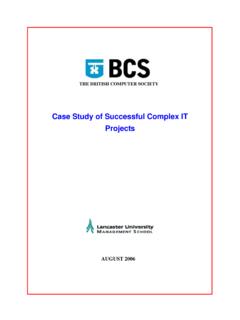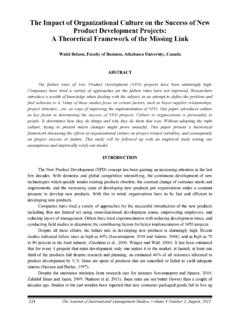Transcription of Complete Projects on Time - Elementool
1 Complete Projects On time The Five Principles to meet your budget and deadlines Beth Schechner Elementool The content of this eBook is provided to you for free by Elementool . You may distribute this eBook to anyone you know. If you quote or use the text in this eBook, we ask that you give us Complete Projects On time The Five Principles to meet your budget & deadlines 92% of large scale IT Projects According to the market research company, Research and Markets, US spending on IT products and services is forecasted to grow to $ billion in 2010ii. However, the estimated cost of IT failures to the US economy is $1 trillion!iii Now we re talking about IT system failures and their net affect on the companies that rely on those systems. But you can bet money on the fact that the institutions and companies experiencing these losses know the IT company who built their system.
2 Furthermore, they re not going to be buying from that company again, much less recommending it to their partners and contacts. In any company, large or small, your reputation is your biggest asset you want to be in that 8% group. If your IT Projects are failing, then you are not going to win the market share you need to compete in that $ billion market! The following 5 principles lay out the steps you should be following, to make sure that your Projects are completed on time , and on budget, successfully. Read them, learn them, know them, teach them and then make them stick. Principle One: Communicate 40% of project managers cited poor communication as the leading cause if IT project failuresiv If everyone involved in your IT project doesn t know what they re working on, when it s due, how to get it done and who the audience is, how can you possibly expect your project to succeed?
3 All of the other principles that come later on rely on your communication, expectations, goals, resources, deadlines, priorities, reports and budgets all need to be available to your team so that they can do their jobs properly. Yes, communicating all of these things can sometimes be difficult, particularly if it s a short project with a tight deadline, or half of your team is located overseas. It doesn t matter. With all of the technology readily available to us today, there is NO excuse for lack of communication. Tools like web-conferencing actually make it possible for your developer in Hyderabad to share his screen with you in New York, to demonstrate how exactly to recreate major bug in your application. If you make it easy for your team to communicate with management, and with each other, they WILL be more productive.
4 If you put up unnecessary roadblocks in communication, you are preventing your team from working cooperatively and making it more difficult for your product to be released on time . However, using every tool at your disposal to encourage communication and knowledge sharing will absolutely save time when it comes to your project lifecycle. If your developers and testers are able to easily communicate and view results from their team members, they can quickly incorporate feedback and issue fixes. As a manager, you should want to do everything you can, and use every tool at your disposal, to facilitate communication between and within teams. Ongoing feedback on the status of bugs and issues and individual test case steps during the Software Development Lifecycle (SDLC), can and will significantly reduce the amount of time your application spends in development.
5 Principle Two: Consolidate Among all IT development Projects , 84 % exceed acceptable constraints of cost, time and qualityv The average person gets 1 interruption every 8 minutes, or 50-60 per day. The average interruption takes 5 minutes, totaling about 50% of the average workday. 80% of those interruptions are typically rated as "little value" or "no value" creating approximately 3 hours of wasted time per We re talking about information and tasks here. Think about your typical day and how often you stop in the middle of one task to do something else; be honest. How much time do you spend looking for one specific email, out of the hundreds in your in-box? Searching for files on your hard drive after forgetting which folder you saved the one you need in?
6 Opening files to find the most recent version or worse yet, working off of an old file version? Asking around for clarification on an issue? Writing reports? Almost every company can improve their process, cut down on tasks and put data within easy reach, but it isn t easy and will require change. Make a policy of saving all company data in a common location, be it a shared server or a cloud application. Enforce this rule. Your project is much more likely to be completed on time if all the relevant project data is easily available and everyone knows where to find it. Just take a second and think about how much time your team will save every day if they don t have to search for files or through emails. Reports could be pulled together quickly, background information on issues or test cases would be right in there with the initial issue report, and your project probably wouldn t run over time or budget.
7 These are small activities that usually take a few minutes but when you sum them up, at the end of the month, you'll find out that a lot of time is wasted. For example: on average your team members spend 15 minutes a day searching for files. This adds up to 5 hours a month of wasted time for each person in your team on this task alone. Principle Three: Prioritize You d be surprised at how much time you, and your development team, are wasting by not assigning priority and severity to every task. Issues come in, bugs are discovered, and new application features are conceived of every day. Every item won t be crucial to fulfilling your business goals, but your team has no way of concretely knowing which tasks are most important to the company unless someone in management tells them.
8 Priority tells your team how important it is that they resolve this issue immediately. Assigning priority and enforcing it, whenever any task or issue is assigned, will make your team work more efficiently. Setting priority is akin to designating a time slot for every task that you assign a team member during the day. Urgent issues and tasks are certain to be tackled first thing in the morning, with low priority items waiting until later on when all others have been completed. With a clear idea of which tasks, issues or tests are most important, your team members can easily plan their days to make the best use of their time . Think about your own work habits. Without prioritizing, it s easy to get caught up in busy work, fielding every new issue that comes in.
9 But just because an issue was the last one to cross your desk Priority: Immediate High importance, this issue should be resolved immediately! High Should be resolved as soon as possible. Medium Should be resolved as soon as any more serious items have been addressed. Low This can wait until all higher priority items have been fixed, or until your next release. doesn t make it the most important. Now think about how you structure your own to-do list? If you think that something is critical, but potentially time consuming, are you more or less likely to put it first on your list? However, if you KNOW that this thing is of highest importance to your boss, does it move up on your to-do list? Severity tells your team how serious the issue or bug is, based on how much it affects your software system.
10 The severity of a bug gives it a more detailed ranking on your team to-do list. If you have 3 high priority issues, then how do you know where to start? By designating severity as well as priority, you re giving your team further direction so they can spend their time working on the most important tasks and get the best results. Teams that know what is expected of them can quickly and efficiently go about their work. It s that simple. Severity: Showstopper Is causing a Complete failure of the system or program. Major Doesn t cause failure but does impair usability. Minor Loss of function with an easy work around. Principle Four: Set Requirements Companies pay 60% more on time and budget using poor requirements practices on Projects .






